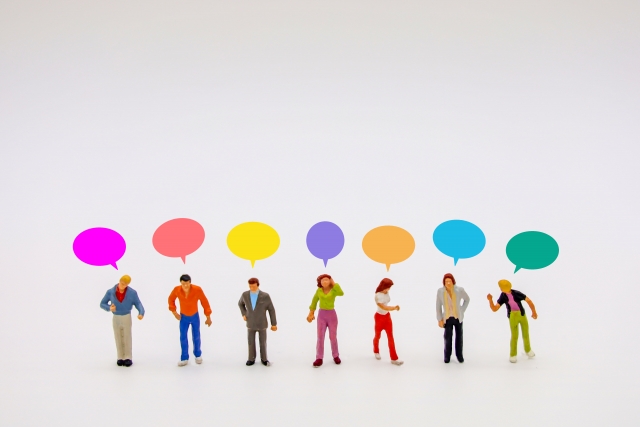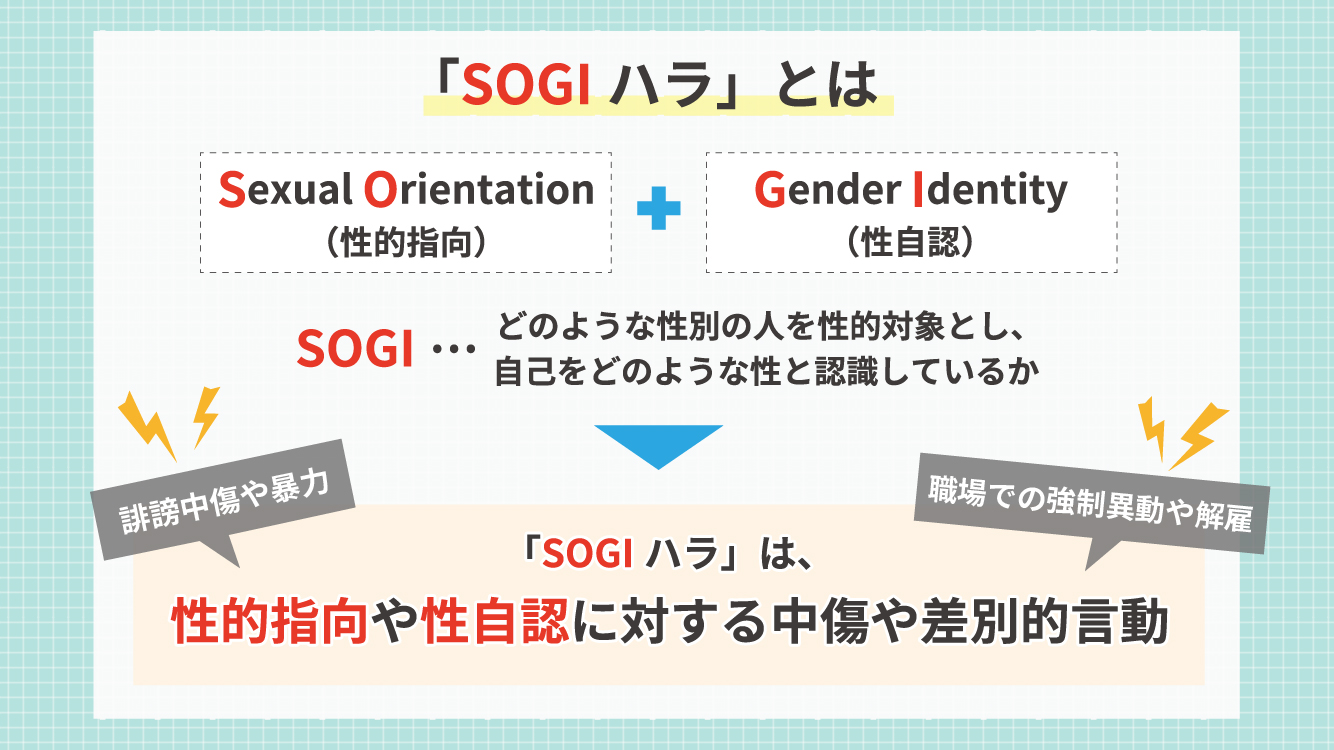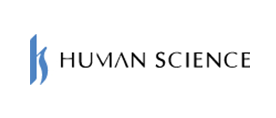2022.09.12
What is SOGI harassment? Measures that companies should take
The definition of harassment is diverse, and in recent years, its types have become increasingly varied. Among them, the one that has recently attracted attention is "SOGI (Sexual Orientation and Gender Identity) harassment."
SOGI harassment refers to harassment related to sexual orientation and gender identity, but many people may still not fully understand it. However, with the implementation of the Power Harassment Prevention Law (Revised Comprehensive Labor Policy Promotion Law) in April 2022, which includes measures against SOGI harassment as an obligation for employers, there is now a demand for understanding SOGI harassment and establishing prevention systems within companies.
In this case, we will explain SOGI harassment from multiple perspectives, including its definition, specific examples, and instances of LGBT training.

1. What is "SOGI" in SOGI Harassment?
Harassment, in essence, refers to "bullying and harassment in various situations," and in a corporate environment where many people are involved, it is a problem that can easily arise without awareness. First, it is necessary to understand the definition of SOGI harassment and change our awareness to prevent issues from occurring.
SOGI is a term that combines the initials of Sexual Orientation and Gender Identity, pronounced as "soji" or "sogi." Let's take a look at the meanings of each word.
●Sexual Orientation
Refers to the direction of romantic or sexual attraction towards a particular gender, or the lack thereof. Some people are attracted to the opposite sex, while others may have romantic feelings for the same sex. There are also various other sexual orientations.
●Gender Identity
This refers to how one perceives their own gender. Some people have a match between their physical sex and their mental gender, while others do not.
From the above, SOGI is a term that represents a person's attributes, referring to "what gender of people one is attracted to and how one recognizes their own gender," and it was born from the idea that "all sexual orientations and gender identities should be respected."
In other words, SOGI harassment refers to the "defamation and bullying based on sexual orientation and gender identity," encompassing discriminatory behavior, ridicule, and mental and physical harassment such as violence. It also includes experiencing discrimination that leads to disadvantages in social life, such as forced transfers, rejection of employment, or dismissal in the workplace.

What is the difference between LGBT and SOGI?
Now, many of you may have thought of the word "LGBT" from the discussion so far. LGBT stands for Lesbian, Gay, Bisexual, and Transgender, representing sexual minorities. Recently, it is also referred to as LGBTQ (where "Q" stands for Queer or Questioning, referring to those who do not fit into any of the categories).
On the other hand, SOGI refers to individual sexual identities and is a concept that applies to everyone. Since it encompasses all sexual orientations and gender identities, including heterosexuality, it is not a matter of saying, "I am not LGBT, so this issue does not concern me." It is a theme that affects everyone, and we must all be aware that we are all stakeholders in SOGI harassment.
2. Specific Examples of SOGI Harassment
In a variety show that aired in 2017, a character that mocked male homosexuals appeared, leading to a flood of criticism. This character had gained attention in the show's comedy segment during the 80s and 90s, and its reappearance after about 30 years became a topic of discussion. However, unlike the time when knowledge and understanding of LGBT issues were not widespread, broadcasting discriminatory expressions in modern television media is, of course, taboo. It is only natural that this case, lacking awareness and consideration for SOGI, faced intense criticism.
This is a typical example, but cases of SOGI harassment can often be seen in our daily lives. Additionally, if one does not possess at least a basic knowledge of gender, there is a possibility that they may unconsciously engage in such behavior.
From here, we will introduce specific examples of SOGI harassment. Let's learn about the various cases to avoid hurting others with our words and actions. It is also important to take notice and action for improvement when encountering such scenes.

(Example 1 of SOGI Harassment) Discriminatory behavior and ridicule, name-calling
Insulting with derogatory terms for homosexuals such as "homo" or "lez," or using words that include criticism or mockery of sexual orientation or gender identity (e.g., "feminine man," "manly woman") constitutes SOGI harassment, even if the speaker has no malicious intent and it was meant as a joke, as it can hurt the feelings of the individuals involved.
(Example 2 of SOGI Harassment) Bullying, Ignoring, Violence
It goes without saying that inflicting physical or mental pain, such as violence or bullying, on individuals due to their sexual orientation or gender identity is SOGI harassment. Additionally, turning a blind eye to such acts can also be considered complicity in SOGI harassment.
(Example 3 of SOGI Harassment) Forcing a life of an undesired gender
Forcing a lifestyle or behavior that ignores a person's gender identity is one form of SOGI harassment. For example, forcing a person whose registered gender is male but identifies as female to wear a male uniform, or failing to consider which restroom they should use, are examples of this.
(Example 4 of SOGI Harassment) Unjust transfers and dismissals
"A woman who dresses as a man will be transferred because she stands out from the team," and "being dismissed because it is uncomfortable for a man to wear makeup" are also considered SOGI harassment when unjust transfers or dismissals are issued based on sexual orientation or gender identity.
(Example 5 of SOGI Harassment) Disclosing SOGI without the individual's consent (Outing)
When someone who knows an individual's SOGI informs others without the person's consent, it is referred to as "outing." This act can also lead to disadvantages for the individual and constitutes SOGI harassment. Additionally, outing raises issues of privacy and the freedom of choice (whether to come out or not), causing emotional distress to the individual.
By the way, coming out refers to the act of an individual revealing their sexual orientation or gender identity to those around them. In contrast, outing refers to the act of someone else disclosing this information without the individual's consent. These two terms have significantly different meanings, so be careful not to confuse them.
3. Companies that provide training and support related to LGBT
To prevent SOGI harassment, it is essential to respect each individual's SOGI and deepen knowledge and understanding of LGBT issues. Some companies have established "LGBT training" sessions to proactively provide accurate information to their employees. Here, we will introduce an example of LGBT training and support that is already being implemented within companies.
●Case of an Electronics Manufacturer
(1) Hosting of In-house Seminars
We will include content on LGBT themes in human rights awareness training for all employees. Additionally, to promote understanding, we invite external experts and organizations to hold workshops and seminars.
(2) Establishment of Internal Consultation Desk
We have established a "Human Rights Consultation Desk" to promote an environment where each employee can fully demonstrate their abilities. In addition to the head office, consultation desks are also set up at various regional offices, focusing on creating a system that is easy to consult.
(3) Improvement of Workplace Environment
If there are requests from transgender employees, support will be provided based on their gender identity (e.g., health check-ups, name display in the workplace, clothing, support for continued employment during treatment or surgery, etc.). Additionally, the introduction of multi-purpose restrooms is being expanded.
(4) Consideration for LGBT in Recruitment Activities
No gender field will be included in the entry sheet. LGBT training is conducted in the recruitment department.

●Case of a Foreign IT Company
(1) Establishment of an Internal Consultation Desk
A dedicated website and social media for LGBT individuals have been set up, allowing for consultations and contact at any time. Questions and inquiries will be handled by leaders from the LGBT community and diversity officers. If the individual does not wish to disclose their name or employee number, they can use the service anonymously.
(2) Improvement of Workplace Environment
Installed "Universal Restrooms" that can be used by anyone, regardless of gender, on all floors of the headquarters and some business locations.
(3) Consideration for LGBT in Recruitment Activities
At each information session, the recruitment officer introduces the company's initiatives for LGBT. Individual consultations are also available.
● Airline Case
(1) Hosting of in-house seminars
Conducting e-learning for HR personnel, management, and all employees in the group.
(2) Establishment of Internal Consultation Desk
A dedicated consultation desk for LGBT has been set up in the Human Resources Department, accepting inquiries via phone and email.
(3) Consideration for LGBT in Recruitment Activities
We ensure that recruitment interviewers are informed about the basics of LGBT, as well as important points to consider during the recruitment process (such as how to respond if someone comes out, and the challenges faced by LGBT job seekers), to promote thorough understanding.

●Insurance Company Case
(1) Hosting of In-House Seminars
Conducting human rights training on the theme of LGBT for all employees. Additionally, special training will be provided for employees in positions that directly interact with customers, such as contact center staff and financial planners.
(2) Establishment of an Internal Consultation Desk
Establish an LGBT-specific consultation desk within the company (dedicated phone and email address) and set up a system to respond to individual consultations.
(3) Creating an Inclusive Workplace Culture
We are recruiting volunteers to participate as a company in external communities and organizations that promote understanding of LGBT. Through this activity, we declare our aim to become an "LGBT-friendly" company and actively promote this, working towards a culture where employees can easily express their opinions about LGBT issues.
In addition to the four companies mentioned above, many other companies are also working to promote understanding of LGBT issues. Furthermore, beyond such awareness activities, it is noticeable that some companies have revised their HR policies to apply to same-sex partners as well, and have explicitly stated in their internal regulations that "discrimination based on sexual orientation or gender identity is not allowed," indicating a proactive stance towards achieving diversity & inclusion.
*Diversity & Inclusion means respecting and acknowledging the diversity of human resources (i.e., diversity) and accepting and utilizing it (i.e., inclusion).
4. What should we do to conduct SOGI harassment training?
Various types of harassment in the workplace. Among them, SOGI harassment related to sexual orientation and gender identity involves strong elements of privacy and requires careful handling. Additionally, without knowledge about gender, there is a risk that we may unintentionally hurt someone, making it a very delicate issue.
So far, we have explained the definition of SOGI harassment, examples, and the initiatives of various companies. To prevent SOGI harassment and create an environment where everyone can work comfortably, it is essential for employees to receive proper training and acquire the correct knowledge.
Therefore, what we would like to propose for efficient SOGI harassment training is e-learning.
E-learning can be accessed anytime and anywhere, allowing for learning at the best timing, making it a convenient tool for busy professionals. Additionally, from the administrator's perspective, it can eliminate various cumbersome tasks such as venue preparation and setting up multiple classes, and it is also expected to reduce costs compared to in-person training.

The e-learning materials on human science allow for thorough learning not only about SOGI harassment but also about the "three major harassments": power harassment, sexual harassment, and maternity harassment. Furthermore, it is appealing that the materials provide practical content, including appropriate actions to take and consultation points when one experiences or notices harassment.
As many companies are taking various initiatives towards realizing a diverse society, why not start with an easy-to-implement e-learning program to raise awareness about SOGI harassment and promote a change in employee consciousness?
Please check this as well.
STOP! Harassment - Basic Knowledge of Workplace Harassment -
Source: From the document "Towards the Realization of a Diversity and Inclusion Society" published by the Japan Business Federation in 2017
Author:
Shizuko Sase
Education Solutions Department Production Group Writer
After joining Human Science, worked as a technical writer,
gaining experience in the design and writing of product manuals and operational manuals.
Subsequently engaged in writing and production direction of e-learning materials.
Involved in the production of approximately 200 educational materials to date.
Contact Information:
Phone Number: 03-5321-3111
hsweb_inquiry@science.co.jp












